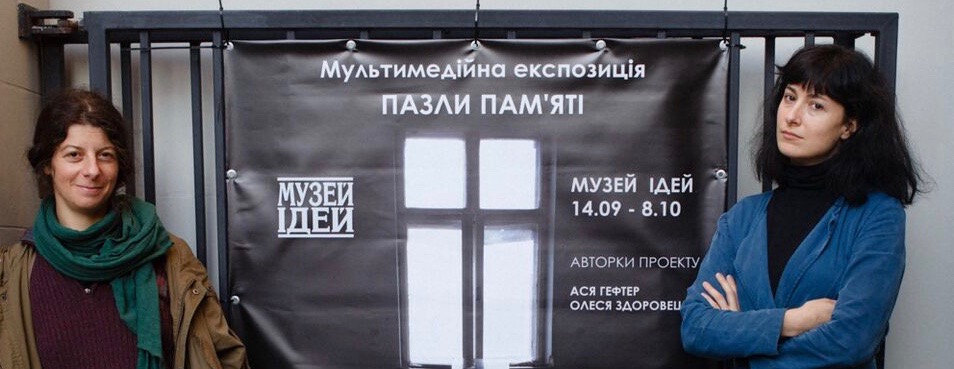

Asya Gefter: Fragments of Memory (1/2)
« Fragment of Memory » 1/2
1 / In Lviv, just finished the exhibition that you realized, « Fragments of Memory ». You yourself were born in Moscow, of a Jewish family and live in Great Britain. So why Lviv? Can you tell us about the genesis of this project?
I was indeed born in Moscow. Looking back at my growing up in an assimilated environment, I recall not understanding what it was to be Jewish, why my nose was the way it was, why my surname was different from many others, why some kids called me derogatory names. Despite occasionally celebrating Jewish holidays at my great-aunt’s flat, I felt disconnected from the traditions of my grandparents who never talked about their childhood in Ukraine and Belorussia. Besides, I did lots of sport unlike anyone else in my family circle, what added to the lack of understanding of who I was and of the world around.
I was 19 when I went to Israel. I was independent since an early age, but this first solo travelling opened the door – I felt free for the first time. So when a friend of my father asked me what were my plans, I surprised myself by saying I wanted to go to Europe. But nobody waits for us in Europe?! – his words hung in the air. On my return to Moscow, I became driven like never before – I had to get to Europe. Dutch scholarship, student visas, odd jobs, and in 2003 I found the place I fell in love with – London. London shaped me. Local and global stories, people from all walks of life. An outsider in me was accepted here and yet I kept looking for something – I wished to belong but not to get lost. Through doing London-based and overseas projects about other communities (What is Chats Palace?, From Pop Art to Community Arts, Playing In or Out?, PICS, War on the Home Front, Ikakumo) I was searching for my own identity.
My grandfather was a historian who said that genocide is never against someone, genocide is always against everyone. He never talked about growing up without a father, about losing his mother and cousin in the Holocaust and his uncle in Stalin’s purges. For him, as for many people of his generation, there was a life before WWII and a life after. But I knew none of it when in Spring 2015, out of the blue, an email from my uncle popped up. Attached were the scans of four postcards sent by my great-grandmother shortly before she was killed in the mass-murder of Jewish population in Crimea in 1941. It was the first time I heard about her. She had a name. She was a piano teacher.
A few months later, my new musician friend from Ukraine, Olesya Zdorovetska, invited me to come with her to Lviv, to the annual Book Forum. I agreed without a slight hesitation. Those postcards were on my mind, even though Lviv and Crimea are 1000 km apart. I also felt the urge to revisit my childhood places in the Carpathian Mountains, near Lviv. But most importantly, after years of wanderings, I felt like I was getting closer to finding the right doors.
With Olesya and alone, I explored the cobble streets, peeped into Lviv courtyards, climbed onto the roofs, wandered in the cemeteries. At the Book Forum Olesya bought a collection of poetry by Debora Vogel, a female writer, art critic and intellectual, who perished in Lviv ghetto in 1942 and remained in obscurity for a long time. Dr. Karolina Szymaniak from Poland introduced her work to the world in the last decade. Over the next two years, we walked the places Vogel inhabited and wrote about, met people who survived the war or were born long after and reconnected with the disappeared world. We have encountered the story of the former Jewish museum.
What is remembered and what is forgotten? How do you talk about what you can’t know? The work that resulted from our journey is concerned with the fragmented nature of memory, the presence and absence of people, personal stories pointing to Leopolis/Lemberg/Lwow/Lviv.
2 / What is the figure of Debora Vogel for you? A favourite quote from her poetry?
Between the two wars Lviv was this inspiring metropolis for modernist thought in philosophy, mathematics, literary theory and arts, as well as a place of social and ethnic conflicts. It was among Lviv intellectuals and artists, during the period of rising chauvinism and anti-semitism, that the idea of an inclusive and open culture was formed. Vogel wrote in Polish, Hebrew, German and Yiddish which she learned as an adult. She moved between different languages, cultures, groups, and places offering reflections on the contemporary urban experience, mass culture, women’s presence in the public space, social exclusions and colonialism. For me, Vogel became this figure who epitomised Lviv as a microcosm of Europe’s 20th century and my own concept of European identity – the melting pot of different mentalities, cultures and ethnicities, in which I was looking for myself.
The first three lines of Vogel’s poem ‘Hayzer baynakht’ (Top Figurn, 1930) resonated with me the most and so we chose them to welcome the visitors as they entered the exhibition space, aka the leitmotif of the show.
hayzer baynakht (Yiddish transliteration)
nakhtlekhe gasn voltn zayn farloyrn
un mir voltn zayn farlozn:
ven nisht hayzer.
Будинки вночi (translated by Yurko Prokhasko)
нічні вулиці були би втрачені,
а ми були би покинуті:
якби не будинки.
Houses at Night (translated by Anastasiya Lyubas)
night streets would be lost
and we would be abandoned:
if not for the houses.